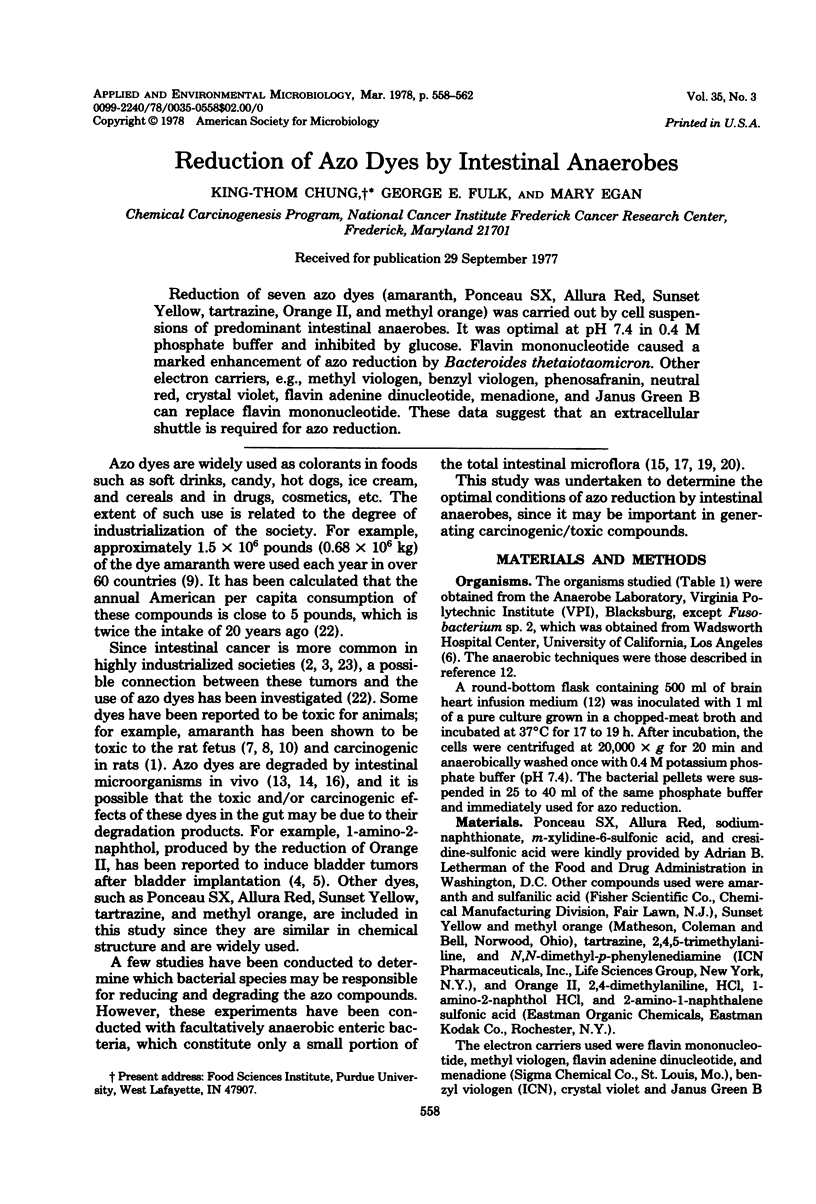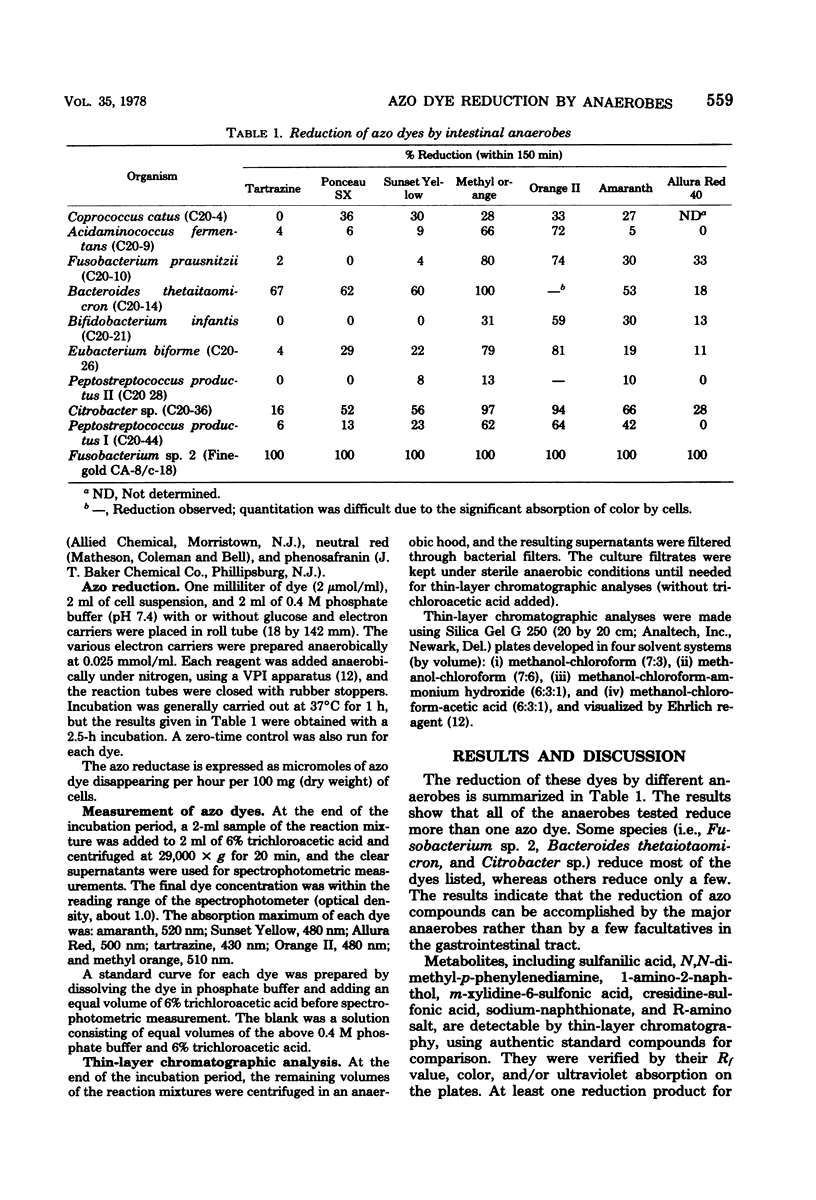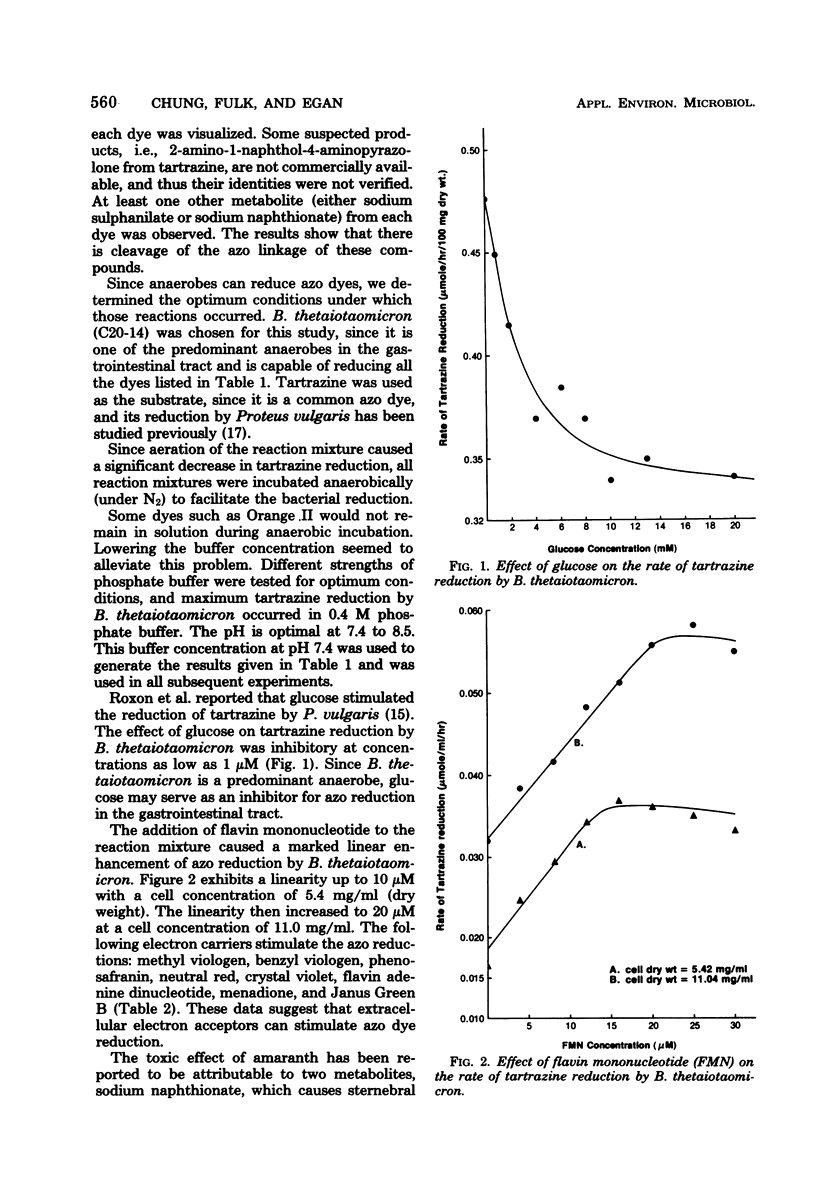Abstract
Reduction of seven azo dyes (amaranth, Ponceau SX, Allura Red, Sunset Yellow, tartrazine, Orange II, and methyl orange) was carried out by cell suspensions of predominant intestinal anaerobes. It was optimal at pH 7.4 in 0.4 M phosphate buffer and inhibited by glucose. Flavin mononucleotide caused a marked enhancement of azo reduction by Bacteroides thetaiotaomicron. Other electron carriers, e.g., methyl viologen, benzyl viologen, phenosafranin, neutral red, crystal violet, flavin adenine dinucleotide, menadione, and Janus Green B can replace flavin mononucleotide. These data suggest that an extracellular shuttle is required for azo reduction.
Full text
PDF




Selected References
These references are in PubMed. This may not be the complete list of references from this article.
- Andrianova M. M. Kantserogennye svoistva krasnykh pishchevykh krasitelei amaranta, puntsovogo SX i puntsovogo 4R. Vopr Pitan. 1970 Sep-Oct;29(5):61–65. [PubMed] [Google Scholar]
- BONSER G. M., BRADSHAW L., CLAYSON D. B., JULL J. W. A further study of the carcinogenic properties of ortho hydroxy-amines and related compounds by bladder implantation in the mouse. Br J Cancer. 1956 Sep;10(3):539–546. doi: 10.1038/bjc.1956.63. [DOI] [PMC free article] [PubMed] [Google Scholar]
- BONSER G. M., CLAYSON D. B., JULL J. W. THE POTENCY OF 20-METHYLCHOLANTHRENE RELATIVE TO OTHER CARCINOGENS ON BLADDER IMPLANTATION. Br J Cancer. 1963 Jun;17:235–241. doi: 10.1038/bjc.1963.33. [DOI] [PMC free article] [PubMed] [Google Scholar]
- Berg J. W., Howell M. A. The geographic pathology of bowel cancer. Cancer. 1974 Sep;34(3):suppl–suppl:814. doi: 10.1002/1097-0142(197409)34:3+<807::aid-cncr2820340704>3.0.co;2-4. [DOI] [PubMed] [Google Scholar]
- Chung K. T., Fulk G. E., Slein M. W. Tryptophanase of fecal flora as a possible factor in the etiology of colon cancer. J Natl Cancer Inst. 1975 May;54(5):1073–1078. doi: 10.1093/jnci/54.5.1073. [DOI] [PubMed] [Google Scholar]
- Collins T. F., Black T. N., Ruggles D. I. Long-term effects of dietary amaranth in rats. II. Effects on fetal development. Toxicology. 1975 Jan;3(1):129–140. doi: 10.1016/0300-483x(75)90014-1. [DOI] [PubMed] [Google Scholar]
- Collins T. F., Keeler H. V., Black T. N., Ruggles D. I. Long-term effects of dietary amaranth in rats. I. Effects on reproduction. Toxicology. 1975 Jan;3(1):115–128. doi: 10.1016/0300-483x(75)90013-x. [DOI] [PubMed] [Google Scholar]
- Collins T. F., McLaughlin J. Teratology studies on food colourings. I. Embryotoxicity of amaranth (FD & C red No. 2) in rats. Food Cosmet Toxicol. 1972 Oct;10(5):619–624. doi: 10.1016/s0015-6264(72)80142-1. [DOI] [PubMed] [Google Scholar]
- Collins T. F., McLaughlin J. Teratology studies on food colourings. II. Embryotoxicity of R salt and metabolites of amaranth (FD and C Red no. 2) in rats. Food Cosmet Toxicol. 1973 Jun;11(3):355–360. doi: 10.1016/0015-6264(73)90001-1. [DOI] [PubMed] [Google Scholar]
- DANIEL J. W. The excretion and metabolism of edible food colors. Toxicol Appl Pharmacol. 1962 Sep;4:572–594. doi: 10.1016/0041-008x(62)90085-6. [DOI] [PubMed] [Google Scholar]
- JONES R., RYAN A. J., WRIGHT S. E. THE METABOLISM AND EXCRETION OF TARTRAZINE IN THE RAT, RABBIT AND MAN. Food Cosmet Toxicol. 1964 Oct;2:447–452. doi: 10.1016/s0015-6264(64)80287-x. [DOI] [PubMed] [Google Scholar]
- Larsen J. C., Meyer T., Scheline R. R. Reduction of sulphonated water-soluble azo dyes by caecal microorganisms from the rat. Acta Pharmacol Toxicol (Copenh) 1976 Apr;38(4):353–357. doi: 10.1111/j.1600-0773.1976.tb03130.x. [DOI] [PubMed] [Google Scholar]
- Roxon J. J., Ryan A. J., Wright S. E. Enzymatic reduction of tartrazine by Proteus vulgaris from rats. Food Cosmet Toxicol. 1967 Nov;5(5):645–656. doi: 10.1016/s0015-6264(67)83216-4. [DOI] [PubMed] [Google Scholar]
- Roxon J. J., Ryan A. J., Wright S. E. Reduction of tartrazine by a Proteus species isolated from rats. Food Cosmet Toxicol. 1966 Aug;4(4):419–426. doi: 10.1016/s0015-6264(66)80583-7. [DOI] [PubMed] [Google Scholar]
- Roxon J. J., Ryan A. J., Wright S. E. Reduction of water-soluble azo dyes by intestinal bacteria. Food Cosmet Toxicol. 1967 Aug;5(3):367–369. doi: 10.1016/s0015-6264(67)83064-5. [DOI] [PubMed] [Google Scholar]
- Ryan A. J., Roxon J. J., Sivayavirojana A. Bacterial azo reduction: a metabolic reaction in mammals. Nature. 1968 Aug 24;219(5156):854–855. doi: 10.1038/219854a0. [DOI] [PubMed] [Google Scholar]
- Scheline R. R., Nygaard R. T., Longberg B. Enzymatic reduction of the azo dye, acid yellow, by extracts of Streptococcus faecalis isolated from rat intestine. Food Cosmet Toxicol. 1970 Feb;8(1):55–58. doi: 10.1016/s0015-6264(70)80223-1. [DOI] [PubMed] [Google Scholar]
- Walker R., Gingell R., Murrells D. F. Mechanisms of azo reduction by Streptococcus faecalis. I. Optimization of assay conditions. Xenobiotica. 1971 May;1(3):221–229. doi: 10.3109/00498257109033171. [DOI] [PubMed] [Google Scholar]
- Westö G. On the metabolism of tartrazine in the rat. Acta Chem Scand. 1965;19(6):1309–1316. doi: 10.3891/acta.chem.scand.19-1309. [DOI] [PubMed] [Google Scholar]
- Wolff A. H., Oehme F. W. Carcinogenic chemicals in food as an environmental health issue. J Am Vet Med Assoc. 1974 Mar 15;164(6):623–629. [PubMed] [Google Scholar]
- Wynder E. L., Reddy B. S. Metabolic epidemiology of colorectal cancer. Cancer. 1974 Sep;34(3):suppl–suppl:806. doi: 10.1002/1097-0142(197409)34:3+<801::aid-cncr2820340703>3.0.co;2-p. [DOI] [PubMed] [Google Scholar]


